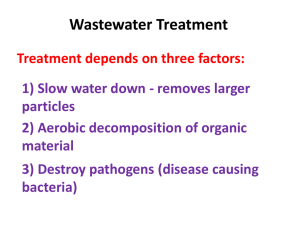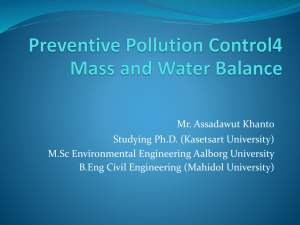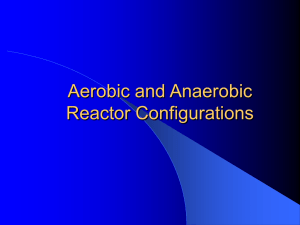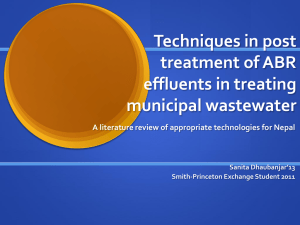Microsoft Word
advertisement
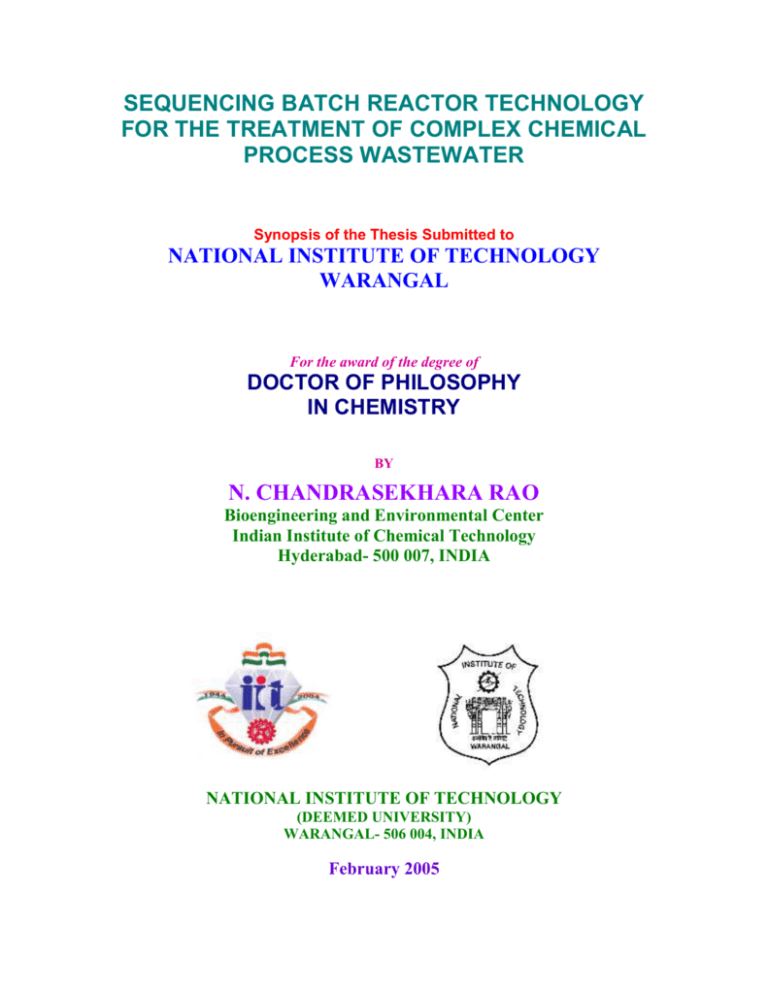
SEQUENCING BATCH REACTOR TECHNOLOGY FOR THE TREATMENT OF COMPLEX CHEMICAL PROCESS WASTEWATER Synopsis of the Thesis Submitted to NATIONAL INSTITUTE OF TECHNOLOGY WARANGAL For the award of the degree of DOCTOR OF PHILOSOPHY IN CHEMISTRY BY N. CHANDRASEKHARA RAO Bioengineering and Environmental Center Indian Institute of Chemical Technology Hyderabad- 500 007, INDIA NATIONAL INSTITUTE OF TECHNOLOGY (DEEMED UNIVERSITY) WARANGAL- 506 004, INDIA February 2005 Synopsis ______________________________________________________________________________________ Industrial wastewater originating from chemical industries normally contains toxic organic compounds, solvents, inorganic chemicals, salts, etc. and the characteristics of wastewater are highly variable and complex in nature [1-3]. The consumption of large quantities of organic and inorganic chemicals in the process imparts low biodegradability to the wastewater and the presence of recalcitrant organic molecules due to their nonbiodegradable nature inhibits the biological process. Excessive usage of inorganic salts in the process results in high salt concentration in wastewater, thereby inhibiting the biological treatment process due to plasmolysis and/or loss of biological activity. The complexity of the wastewater is characterized by the presence of toxic/recalcitrant organic compounds, solvents and inorganic chemicals [3]. Presently there are over 70,000 synthetic organic chemicals termed as refractory compounds, which are difficult to treat, by conventional biological processes owing to the inhibition and toxicity of these compounds when they serve as microbial substrates. The variability of the wastewater on both flow and composition (change of manufacturing product, transitory operation of the plant, washing, etc.) also influences the efficiency of the treatment [3]. Treatment of this wastewater is of great concern to the scientists working in the field of environmental pollution control and the existing stringent environmental regulations need effective treatment methodologies for the wastewater to meet the regulatory norms. The biological treatment of complex chemical process wastewater is particularly challenging due to their low biodegradable nature and transient flow conditions. Efficiency of the biological process to treat wastewater containing toxic and recalcitrant compounds depends on the presence of appropriate microorganisms, system acclimatization and specific operational conditions of the bioreactor. Continuous flow biological systems such as activated sludge process have serious difficulties in treating this type of wastewater. Effective biological transformation of complex industrial wastewater requires the activity of microbial communities with vast metabolic ranges [4]. Complex synergistic and antagonistic relationships exist between the various microbial species present and the microbial species forming the community can differ greatly in growth rate and yield. This is especially evident when the organisms are to be selected and enriched wherein their physiological states will be adjusted in an 2 Synopsis ______________________________________________________________________________________ environment alternating between aerobic, anoxic and anaerobic conditions. The maintenance of robust population capable of meeting the desired effluent limits is further exacerbated when transient or shock load conditions occur. Recently, considerable interest in the research fraternity is observed in the application of alternative approaches like periodic discontinuous processes for wastewater treatment. Periodic discontinuous process was developed on the basic scientific assumption that periodic exposure of the microorganisms to defined process conditions is effectively achieved in a fed batch system wherein exposure time, frequency of exposure and amplitude of the concentration can be set independently of any inflow condition [4]. This process is distinguished by the enforcement of controlled short-term unsteady state conditions, leading in the long run to a stable steady state with respect to composition and metabolic properties of the microbial population growing in the reactor leading to the control of the distribution and physiological state of the microorganisms. Systems submitted to conditions of feast and famine have higher specific growth rates and saturation constants than systems with constant conditions. In biological processes, intermittent process has been shown to produce higher specific growth rates of bacteria. The concept of periodic discontinuous process using sequencing batch reactor (SBR) operation was first reported in 1983. Application of this technology for domestic wastewater treatment especially for the removal of nutrient was documented after 1994 onwards [4-10]. SBR technology differs in various ways from conventional technologies used in biological treatment of wastewater. The most obvious difference is that in SBR technology, the reactor volume varies with time, where as it remains constant in the traditional continuous flow system. The advantages of SBR technology include the flexibility of operation (change of phase), feasibility of operation at low retention time, control over microbial population and various reactor configurations. SBR process consists of several time oriented periodic steps, characterized by a series of process phases viz. fill, react, settle, decant and idle, each lasting for a defined period during which wastewater is treated. The success of SBR technology depends on the great potential provided by the possibilities of influencing the microbial system in the reactor. 3 Synopsis ______________________________________________________________________________________ SBR processes are comparatively easy to operate and cost efficient and this process saves more than 60% of the expenses when compared to conventional activated sludge process [5]. Interest has been growing across the world both in scientific research and in practical application of SBR technology. SBR with various reactor configurations for nutrient removal has been studied extensively. One of the main advantages of SBR is the enhanced phosphorus removal due to phosphate accumulation during the anaerobic process and utilization in the subsequent aerobic process of the sequence. So far, SBR has been successfully applied for the treatment of domestic wastewater, medium and lower strength landfill leachates, specific pollutants and contaminated soils. Very few applications of SBR for industrial wastewater treatment (dairy, tannery, swine, etc.) were reported in the literature [11-23]. A thorough literature search revealed that SBR technology has not been investigated with complex chemical wastewaters from pharmaceutical, drug and chemical process units. In this context, the research work in the thesis focused on the investigation of periodic discontinuous process using sequencing batch reactor (SBR) application especially for the treatment of complex chemical wastewater. The experiments conducted in this have been selected, performed and analyzed with the ultimate goal of optimizing the SBR process with respect to metabolic functions, sequence phase microenvironment and reactor configuration. More specifically an depth attempt has been made to correlate the various reactor performance parameters to arrive at the best possible configuration for achieving process optimization. The work was taken up with the following broad objectives To investigate the application of periodic discontinuous process using sequencing batch reactor (SBR) technology for treating complex chemical wastewaters. To enumerate the relative efficiency of various reactor configurations such as suspended growth, biofilm, granular, immobilized and granular activated carbon (GAC) To elucidate the role of various metabolic functions (aerobic and anaerobic) on the process performance 4 Synopsis ______________________________________________________________________________________ To investigate the influence of metabolic shift on the process performance To elicit the multiphase microenvironment/redox condition variation on the process performance during sequence phase operation. To elucidate the application of Taguchi dynamic design of experimental (DOE) methodology for optimization of anaerobic process To explore the effect of bioaugmentation strategy to enhance the process performance. The thesis is divided into eight chapters. The schematic representation of the thesis with respect to chapters is shown in Figure 1. Chapter 1: Introduction This chapter introduces the problem of complex wastewater treatment by biological processes and stresses the need for the alternative biological methods for effective and enhanced process performance. This chapter also presents the global scenario and conceptual framework of the thesis topic. Literature on the chemical process industries especially with process variations and wastewater generation along with the present state of biological methods used for the treatment of such kind of wastes are discussed. The concept of periodic discontinuous process operation and sequencing batch reactor technology are critically reviewed. Description of the basic process with the theoretical concepts of periodic discontinuous process along with operational steps involved and process variations forms part of the chapter. Various process variations normally observed in SBR operation such as metabolic functions, sequence phase microenvironment and reactor operating conditions are discussed in detail. The design normally adopted for SBR process and critical factors to be considered during the design are enumerated. Relative advantages of periodic discontinuous processes operation with traditional/continuous processes are comparatively evaluated. Scope and flexibility of SBR operation and its application for the treatment of wastewater such as domestic sewage, landfill leachates, industrial wastewater and specific pollutants are reviewed. Concepts of bio-nutrient removal, decolorisation of dye and soil decontamination by slurry phase bioreactors with respect to SBR technology are also included in this chapter. 5 Synopsis ______________________________________________________________________________________ Figure 1: Schematic diagram of the thesis presentation 6 Synopsis ______________________________________________________________________________________ Chapter 2: Scope and objective of the study This chapter outlines the scope and the objectives of the present work. Chapter 3: Experimental Methodology Chapter 3 describes in detail the materials used in the experiments along with the experimental methodology adopted in the study for achieving the specified objectives of the work. Details of wastewater used as feed for treatment and its characteristics, reactor design and fabrication procedures adopted and analytical methods used for monitoring the biological process are discussed in detail. The experimental details such as reactor configurations, metabolic functions and sequence phase variations, reactor operation, sampling protocols, etc are incorporated in this chapter. The feasibility of SBR technology is investigated with three kinds of complex chemical wastewater i.e. composite chemical wastewater (CCW), single process chemical wastewater (SPCW) and simulated azo dye wastewater (SDW) for assessing the process efficiency. Reactor configurations such as suspended growth, granular, biofilm, GAC biofilm, immobilized and hybrid are investigated to understand their relative efficiency in treating the complex wastewater in periodic discontinuous operation. Chapter 4: Chemical Wastewater Treatment by Periodic Discontinuous Process using Sequencing Batch Reactor (SBR) Technology: Reactor Configuration and Metabolic Function Optimization This chapter presents experimental data pertaining to complex chemical wastewater using various configurations of SBRs using aerobic and anaerobic metabolic functions along with detailed discussions. A total of eight reactor configurations with aerobic and anaerobic metabolic functions were designed for carrying out detailed experiments for the treatment of CCW. Further, the selected effective reactor configuration was studied with two other types of chemical wastewater for assessing the reactor performance in detail. The experimental data has been organized according to various experimental phases that, in turn, approximately follow the chronological order in which they are conducted. The discussion was mainly focused on the reactor performance with respect to 7 Synopsis ______________________________________________________________________________________ substrate degradation rate (SDR) with the function of organic loading rates (OLRs) studied and compared with corresponding continuous mode systems. The process performance of individual reactor configuration was monitored and evaluated for every reactor. The experiments revealed the process efficiency of periodic discontinuous processes in treating complex chemical wastewater compared to continuous flow systems. Significant enhancement in substrate degradation rate in a rapid retention time (24 hours) is observed in SBR reactor operated with suspended growth mode (anoxicaerobic-anoxic) compared with continuous mode operated activated sludge process (retention time-5 days). GAC configured aerobic SBR system showed enhanced performance over corresponding suspended growth system. Reactor operated with immobilized (entrapped acclimatized aerobic mixed consortia) configuration in SBR mode resulted in 70% of COD removal, which is comparatively on the higher side of the corresponding suspended growth system. Overall, biofilm configured SBRs irrespective of metabolic function exhibited effective performance over other configurations studied. Also, bioflm systems resulted in high SDR, while suspended growth systems showed inhibition to system operation after an organic loading rate of 3.5 Kg COD/cum-day. Experimental data revealed that the efficiency of aerobic metabolic functions over the corresponding anaerobic systems studied. This may be reasoned due to the fact that, the SBR operated has relatively less retention time to accomplish anaerobic reaction treating complex chemical wastewater. Other than suspended growth system, the remaining configurations studied retained the substrate removal efficiency at higher OLRs. However, hybrid configuration with biofilm integrated immobilized (anaerobic mixed consortia) resulted in effective performance with respect to substrate degradation. Sulphate reduction of about 10% was evidently observed in aerobic SBR operation, which may be attributed to the prevailing anoxic conditions in the sequence/cycle phase operation. consistently. In the case of anaerobic operation, 70% sulphate reduction is noticed Overall, the SBR configurations studied for the treatment of CCW exhibited the performance efficiency in the order of Biofilm (aerobic) > Immobilized (aerobic) > GAC (aerobic) > Biofilm (anaerobic) > Immobilized (anaerobic) > Granular/suspended (anaerobic) > Suspended (aerobic). 8 Synopsis ______________________________________________________________________________________ Among the metabolic functions studied, aerobic systems showed effective performance over the corresponding anaerobic systems in case of CCW and SPCW wastewater. In case of SDW, anaerobic processes are more favored and yield maximum substrate removal compared to the corresponding aerobic system. This may be attributed to the fact that azo dye initial breakdown needs anaerobic environment. The results obtained with CCW indicated that the biofilm configured SBR showed effective performance compared to other configurations studied and subsequently experiments with SPCW and SDW were carried out with biofilm systems operated in SBR mode. Experiments with SPCW are investigated at higher organic loading rates (up to 14.76 Kg COD/cum-day) with 24 hours of retention time. At higher organic loading rate, biofilm configured system resulted in 60% of COD removal along with 88% of BOD removal without any system inhibition. In the case of SDW, complete removal of dye color is observed for all the SBR variations studied. However, combination of anaerobic and aerobic metabolic functions resulted in effective performance. Chapter 5: Influence of Metabolic Shift and Multiphase Microenvironment/ Redox Conditions on the Process Performance Chapter 5 presents experimental results related to metabolic shift and multiphase microenvironment/redox conditions variation studies performed on biofilm configured SBRs using all the three kinds of wastewaters. Experiments were carried out with the combination of metabolic shifts (aerobic to anaerobic and anaerobic to aerobic) with the function of wastewater type, OLR and HRT to assess the relative advantages of the shifts on the process performance. The metabolic shift revealed to have significant influence on the overall process efficiency of the periodic discontinuous process. The performance efficiency was found to be governed by the type of wastewater being treated, placement of the metabolic function in integration and HRT. Anaerobic to aerobic shift showed higher performance efficiency over the aerobic-anaerobic shift of the metabolic functions. In case of SDW also, anaerobic to aerobic metabolic shift resulted in effective performance. Twenty experiments varying sequence phase microenvironment in biofilm configured aerobic systems were carried out. Experimental results with multiphase microenvironment studies revealed the influence of redox conditions in the reaction 9 Synopsis ______________________________________________________________________________________ phase of the sequence phase operation and has significant influence on the overall process efficiency of periodic discontinuous operation. Inclusion of anoxic microenvironment in reaction phase of aerobic SBR has showed positive influence on the process efficiency. Multiphase placement of anoxic microenvironment in reaction phase of sequence operation has positive influence on the overall performance of the SBR. Prolonged anoxic microenvironment provision without multiple shifts in reaction phase of the cycle operation showed retarded performance efficiency. Anaerobic microenvironment showed more efficiency compared to prolonged placement of anoxic redox condition in the reaction phase in SBR operation. The extent of HRT showed to have positive influence an overall process performance. Altering sequence phase microenvironment with anoxic and aerobic phase (each for 2 hours) resulted in enhanced performance compared to other combinations studied. Inclusion of anoxic phase in sequence phase operation for extended/longer periods showed process inhibition (substrate removal) over repeated altering of anoxic and aerobic phase for short periods. Chapter 6: Optimization of anaerobic process treating complex chemical wastewater in sequencing batch biofilm reactor (AnSBBR) by Taguchi Dynamic DOE Methodology Chapter 6 presents results pertaining to the studies performed for the optimization of anaerobic process (series of biological processes manifested by complex multi-species reactions) of wastewater treatment using design of experimental methodology (DOE) using dynamic approach. The methodology designed in this study by adopting Taguchi DOE procedure using dynamic approach for optimization of anaerobic processes was first time reported. The study demonstrated the applicability of robust/dynamic design with Taguchi methodology was possible by taking into consideration the uncontrollable/noise factors for process optimization and to understand the role of factors involved in the dynamic anaerobic processes operation for treating the complex chemical wastewater. This approach helped to identify the influence/contribution of individual factors, to arrive at the relationship between variables and operational conditions and finally, to establish the performance at the optimum levels, using a few well defined experimental sets. The Taguchi method has provided a systematic and efficient mathematical approach to understand complex multi-species manifested in anaerobic 10 Synopsis ______________________________________________________________________________________ process for the optimization of the near optimum design parameters, only with a few well defined experimental sets. Chapter 7: Bioaugmentation of anaerobic sequencing batch biofilm reactor (AnSBBR) for the treatment of sulfate bearing chemical wastewater This chapter presents experimental data related to the investigation carried out on the application of bioaugmentation strategy to enhance the process efficiency of anaerobic sequencing batch biofilm reactor (AnSBBR) treating the sulfate bearing chemical wastewater by augmentation with enriched SRB consortia in an entrapped matrix. The results demonstrated the successful application of bioaugmentation strategy by means of enriched SRB consortia in an entrapped form to enhance the overall performance of the reactor for the treatment of chemical wastewater with high sulfate content operated in sequencing batch mode. Significant enhancement in the overall process performance of the reactor was observed after the augmentation. COD removal efficiency was found to increase from 35 to 70% with concomitant increase in biogas yield. Further, sulfate reduction had increased significantly from 27% to 80%. Chapter 8: Summary and Conclusions This chapter summarizes the work presented in the thesis and presents the important conclusions drawn from this study. The experimental data obtained from this investigation demonstrated the efficiency of periodic discontinuous process over the continuous operation in treating the complex wastewater. The maximum substrate degradation rate was evidenced at less HRT compared to continuous systems. The SBR systems showed to sustain their performance at higher OLRs studied. Moreover, the ancillary unit operations such as settling, aeration chamber, etc are all integrated in the single reactor leading to economic operation with less reactor volume. It can be concluded from the compilation of experimental data that the aerobic biofilm configured system operated in periodic discontinuous process operation designed with multiphase anoxic microenvironment rapidly altering between aerobic redox condition (by optimizing the placements and time period of anoxic microenvironment) will yield 11 Synopsis ______________________________________________________________________________________ effective performance with respect to substrate removal efficiency for chemical wastewater. Optimization of HRT, anoxic phase placement and time period, OLR, etc will result in the best performance of periodic discontinuous operation. Flexibility of sequence phase microenvironment variation and prevailing substrate gradient during sequence phase operation facilitated robustness to the system with respect to microflora leading to the effective and stable process performance. Time varying individual components of incoming wastewater places microorganism under nutritional shift (oscillating between feast and famine conditions). This results in maintenance of wide variety and distribution of microbial population in the reactor. Periodic operations with altering feast and famine conditions also resulted in higher uptake of substrate with effective settling of the biomass. Organic loading (shock loads) rates have shown relatively less effect on the performance and at higher loads the stabilization of the reactor is also rapid. The periodic discontinuous operation showed higher flexibility to operate the system under varying metabolic function, reactor configuration and sequence phase operation. Enforced short term unsteady state conditions coupled with periodic exposure of the microorganisms to defined process conditions by controlling their physiological state (incorporating required metabolic conditions) in SBR showed a comparatively efficient performance over the continuous systems in treating complex chemical wastewater. 12 Synopsis ______________________________________________________________________________________ References 1. Venkata Mohan S, Prakasham RS, Satyavathi B, Annapurna J, Ramakrishna SV.2001. Biotreatability studies of pharmaceutical wastewaters using an anaerobic suspended film contact reactor. Water Sci Technol, 43(2), 271-276. 2. Venkata Mohan S, Krishna Prasad K, Prakasham RS, Sharma PN.2002. Enzymatic pretreatment to enhance the biodegradability of industrial wastewaters. Chemical Weekly, 23, 163-168. 3. Venkata Mohan S, Sharma PN. 2002. Pharmaceutical wastewater and treatment technologies. Pharma Bio World, 2(1), 93-100. 4. Wilderer PA. 1994.Sequencing Batch Biofilm Reactor technology. In harnessing biotechnology for the 21st century, (Edt. Lodisch MR and Bose A), American Chemical Society. 5. Chang HN, Moon RK, Park BG, Lim S, Choi DW, Lee WG, Song SL, Ahn YH.2000. Simulation of SBR operation for simultaneous removal of nitrogen and phosphorus. Bioproc Engn., 23, 513-521. 6. Dassanyakee CY, Irvine RL.2001. An enhanced biological phosphorus removal (EBPR) control strategies for SBR’s. Water Sci Technol ., 43(3), 183-190. 7. Daims H, Pursehold U, Bjerrum L, Arnold E, Wilderer PA, Wagner M.2001. Nitrification in sequencing biofilm batch reactor. Water Sci Technol., 43(3):, 918. 8. Efferel T, Wilderer PA.2001.Generation and properties of aerobic granular sludge. Water Sci Technol., 43(3), 19-26. 9. Gieseke A, Arnz P, Amann R, Schramm A. 2002. Simultaneous P and N removal in SBBR: insights from reactor- and microscale investigations. Water Res., 36, 501-509. 10. Venkata Mohan S., R Sirisha, P N Sarma and S J Reddy. 2004.Degradation of hlorpyrifos contaminated soil by bioslurry reactor operated in sequencial batch mode: Bioprocess monitoring. J Hazardous Materials (in Press). 11. Wei-Chi Y, Bonk RR, Lloyd, V J., Sojka, S A.1986. Biological treatment of a landfill leachates in sequencing batch reactor. Environ Prog., 5(1), 41-50. 12. Wilderer PA, Irvine RL, Goronszy MC.2001. Sequencing batch reactor technology. Scientific and Technical Report. IWA Publishing, No 10. 13. Richard O, Mines JR, Dean Milton G.1998. Bionutrient removal with SBR. Water Air Soil Poll., 107, 81-89. 14. Pochana, L, Kellen, J, Lant, P.1999. Model development for simultaneous nitrification and denitrification. Wat Sci Tech.., 39(1), 235-243 15. Rajaguru P, Kalaiselvi K, Palanivel M, Subburam V.2000.Biodegradation of azo dyes in sequencing anaerobic-aerobic systems. Appl Microbiol Biotech., 54, 268-273. 16. Buitron G, Soto G, Vite G, Morena J.2001. Strategies to enhance the biodegradation of toxic compounds using discontinuous process. Water Sci Technol ., 43(3), 283-290. 17. Fu L, Wen X, Lu Q, Quain Y.2001. Treatment of dyeing wastewater in two SBR systems. Proc Biochem , 36, 1111-1118. 13 Synopsis ______________________________________________________________________________________ 18. Giraja S, Wilderer PA.2001. Characterization and treatment of the liquid effluents from an aerobic digestion of biogenic solid waste. Water Sci Technol ., 43(3), 265-274. 19. Irvine, RL Moe, W M. 2001.Periodic biofilter operation for enhance performance during unsteady state loading condition, Wat Sci Tech., 45 (3), 231-239. 20. Juneson C, Ward OP, Sing A.2001.Biodegradation bis(2-ehthyl hexyl) pthalate in soil slurry-sequencing batch reactor. Proc Biochem, 37, 305-313. 21. Yalmaz G, Oztusk I.2001.Biological ammonia removal from an aerobically pretreated leachates in sequencing batch reactors. Water Sci Technol., 43(3), 307-314. 22. Venkata Mohan S, Nancharaiah YV, Falkentoft C, Wattiau P, Wuertz S, Wilderer PA, Hausner M.2002. Monitoring the conjugal transfer of plasmid pWWO from Pseudomonas putida in a Sequential Batch Biofilm Reactor, Proc VAAM Conference, Göttingen. 23. Nacharaya YV, Wattiau P, Werertz S, Bathe S, Venkata Mohan S, Wilderer PA, Hausner M.2003. Dual labelling of Pseudomonas Putida with fluorescent proteins for in situ monitoring of conjugal transfer of TOL plasmid. Applied Envir. Microbiol., 69(8), 4846-4852. 14 Synopsis ______________________________________________________________________________________ Patent and Publications of the Author Patent from the thesis S Venkata Mohan, PN Sarma, N Chandrasekhara Rao, K Krishna Prasad, and KV Raghavan.(2004).Development of sequential batch reactor technology with biofilm configuration for the treatment of complex chemical and pharmaceutical effluents. (PCT. No. WO 2004/087583 A1) Publication from the thesis Published 1. S Venkata Mohan, N Chandrasekhara Rao, K Krishna Prasad, P Murali Krishna, R Sreenivasa Rao and P N Sarma. 2005. Anaerobic Treatment of Complex Chemical Wastewater in a Sequencing Batch Biofilm Reactor: Process Optimization and Evaluation of Factor Interactions Using the Taguchi Dynamic DOE Methodology. Biotechnology and Bioengineering (Galley Proof) 2. S Venkata Mohan, N Chandrasekhara Rao, K Krishna Prasad and PN Sarma. (2005). Bioaugmentation of anaerobic sequencing batch biofilm reactor (ASBBR) with immobilized sulphate reducing bacteria (SRB) for treating sulfate bearing chemical wastewater. Process Biochemistry. 40(8), 2849-2857. 3. S Venkata Mohan, N Chandrasekhara Rao, K Krishna Prasad, BTV Madhavi and PN Sarma. (2005). Treatment of complex chemical effluents by sequencing batch reactor (SBR) with aerobic suspended growth configuration. Process Biochemistry, 40(5), 1501-1508. 4. N Chandrasekhara Rao, S Venkata Mohan and PN Sarma. (2005). Treatment of composite chemical wastewater by GAC-Biofilm configured sequencing batch reactor (SBGR) operated in aerobic environment. J Hazardous Materials (Accepted and in press). 5. S Venkata Mohan, N Chandrasekhara Rao and PN Sarma. (2005). Influence of sequencing phase microenvironment on periodic discontinuous process treating complex chemical wastewater, Water Intelligent Online (accepted). 6. S Venkata Mohan, N Chandrasekhara Rao and PN Sarma. (2005). Simulated acid azo dye wastewater treatment in aerobic suspended growth configured sequencing batch reactor (SBR). Indian Journal of Biotechnology (accepted). Communicated 7. S Venkata Mohan, N Chandrasekhara Rao, K Laxma Reddy and PN Sarma. (2005). Influence of self immobilized GAC configuration in the treatment of complex chemical wastewater in periodic discontinuous operation. Chemosphere (communicated). 15 Synopsis ______________________________________________________________________________________ Other Publications 1. S Venkata Mohan, K Krishna Prasad, N Chandrasekhara Rao, and PN Sarma. (2005). Enzyme mediated degradation of acid azo dye in aqueous phase. Chemosphere, 58, 10971105. 2. S Venkata Mohan, R Sirisha, N Chandrasekhara Rao, PN Sarma and SJ Reddy. (2004). Degradation of chlorpyrifos contaminated soil by bioslurry reactor operated in sequencing batch mode: Bioprocess monitoring. J Hazardous Materials, B116, 39-48. 3. AG Rao, N Chandrasekhara Rao, KK Prasad. GV Naidu, S. Venkata Mohan, Annapoorna Jetty and PN Sarma. (2004). Anaerobic treatment of pharamaceutical wastewater in fixed film reactor. Bioresource Technology, 93, 241-247. 4. AG Rao, KK Prasad. GV Naidu, N Chandrasekhara Rao and PN Sarma. (2004). Removal of sulfide in integrated anaerobic-aerobic wastewater tratment system. Clean Tech Environ Policy, 6, 66- 71. 5. MP Reddy, N Chandrasekhara Rao, K Krishna Prasad, S. Venkata Mohan, PN Sarma, VD Kumari and M Subrahmanyam. (2002). Photocatalytic treatment of common industrial wastewater. Indian J Environ Proct., 22, 1253-1256. 6. S Venkata Mohan, N Chandrasekhara Rao and K Krishna Prasad. (2002). Treatment of simulated Reactive Yellow 22 (azo) dye effluents using Spirogyra Sp. Waste Management, 22, 575-582. 7. S Venkata Mohan, N Chandrasekhara Rao and K Krishna Prasad. (2002). Biological decolorization of simulated basic dye effluents by algal spirogyra species. Asian J Microbiol Biotech Environ Sci., 4(1), 107-111. 8. S Venkata Mohan, N Chandrasekhar Rao and J Karthikeyan (2002).Adsorption removal of direct azo dye from aqueous phase onto coal based sorbents: kinetic and mechanistic study. J Hazardous Materials, 90(2), 189-204. 16


